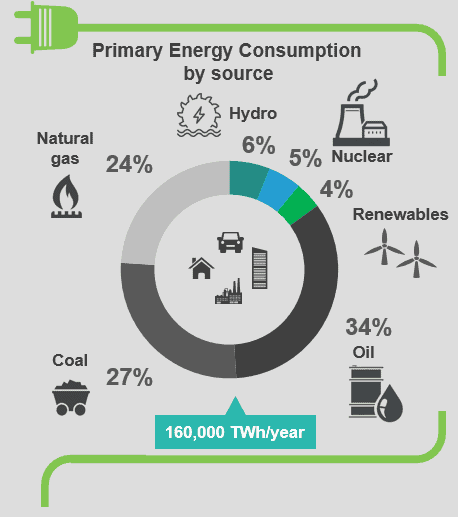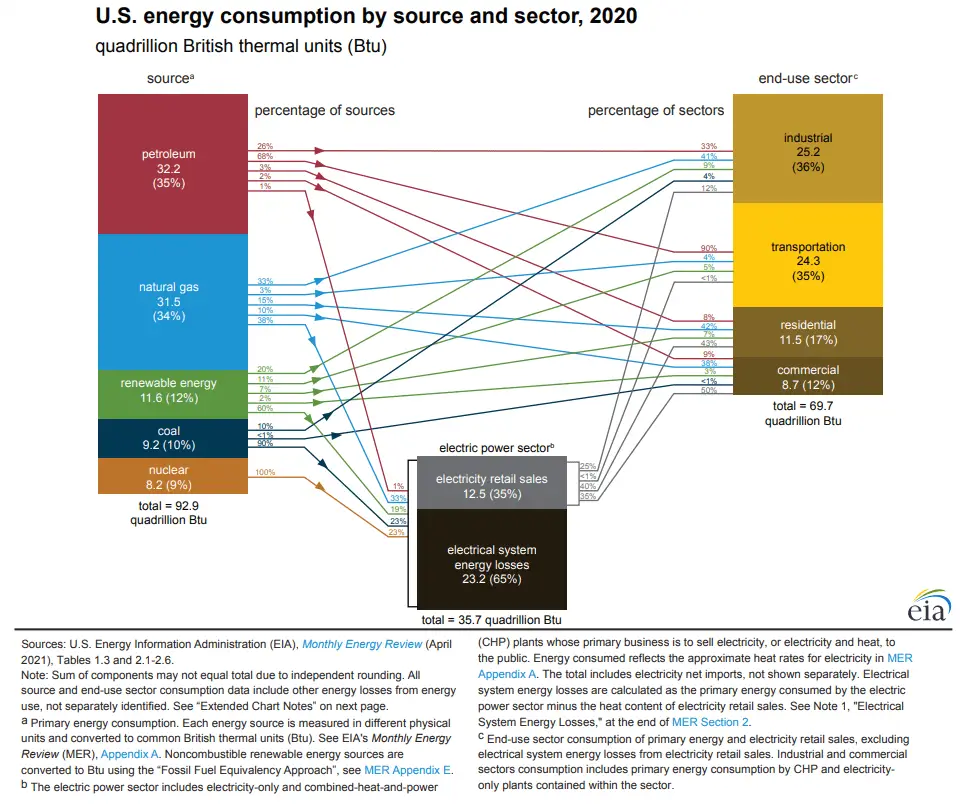How much energy does the world consume?
Energy consumption is growing steadily.
We are totally dependent on fossil fuels.
The world’s main primary energy sources consisted of petroleum (34%), coal (27%), and natural gas (24%), amounting to an 85% share for fossil fuels in primary energy consumption in the world.
Global direct primary energy consumption in 2020 was about 160,000 TWh (576 exajoules or 545 quadrillions BTU).
This is equivalent to three hundred million coal wagons or a mountain of coal 4 times larger than Mount Kilimanjaro.
Energy consumption by source
 Energy is essential for most activities of modern society. Access to abundant, affordable, secure, safe, and clean energy is beneficial for humans. We use energy in the form of firewood, fossil fuels, and electricity to make life comfortable and convenient. Every product you have at home is most likely made of materials obtained from Earth using a lot of energy. At home, we use electricity for our lights and fans, water heater and room heaters, oven, microwave, washing machine, etc. We use petrol, diesel, and CNG for our cars, trucks, buses, etc. A large amount of energy is consumed in agriculture and industry.
Energy is essential for most activities of modern society. Access to abundant, affordable, secure, safe, and clean energy is beneficial for humans. We use energy in the form of firewood, fossil fuels, and electricity to make life comfortable and convenient. Every product you have at home is most likely made of materials obtained from Earth using a lot of energy. At home, we use electricity for our lights and fans, water heater and room heaters, oven, microwave, washing machine, etc. We use petrol, diesel, and CNG for our cars, trucks, buses, etc. A large amount of energy is consumed in agriculture and industry.
As of 2018, the world’s main primary energy sources consisted of petroleum (34%), coal (27%), and natural gas (24%), amounting to an 85% share for fossil fuels in primary energy consumption in the world. A large-scale transition away from fossil energy poses a great challenge for society. The current energy consumption is tremendous, and it is hard to imagine that we can rely on one energy source.
Global direct primary energy consumption in 2020 was about 160,000 TWh (576 exajoules or 545 quadrillions BTU). Assuming that the calorific value of hard coal is 24 GJ / t, then we are talking about the equivalent of 24 billion metric tons of coal, and that’s about 20 billion cubic meters. This is equivalent to three hundred million coal wagons or a mountain of coal 4 times larger than Mount Kilimanjaro.
Please do not forget that this energy gives us sustenance, products, warmth, and life in general.
Energy consumption by sectors
Energy sources are not only consumed in power plants. Industry, transportation, and the residential sector consume even more primary resources than electricity generation.
- The industrial sector is the largest end-use sector in the United States, accounting for 36% in 2020. In 1950, the U.S. industrial sector consumed more coal than any other fuel (40%), but in 2018, coal accounted for just 4% of industrial use. Natural gas is now the most-used fuel in the U.S. industrial sector, accounting for 41% of the industrial total.
- The transportation sector accounted for 35% of energy consumption in 2020. Most energy used for transportation comes from petroleum, but transportation fuels now include natural gas (CNG) or renewable biofuels such as ethanol and biodiesel.
- The residential sector includes homes and apartments, and the commercial sector includes offices, malls, stores, schools, hospitals, etc. In 2018, the U.S. residential sector consumed natural gas (43%) and electricity (42%) in nearly equal shares. Similarly, the U.S. commercial sector’s 2018 energy consumption was mostly natural gas (38%) and electricity (50%).
